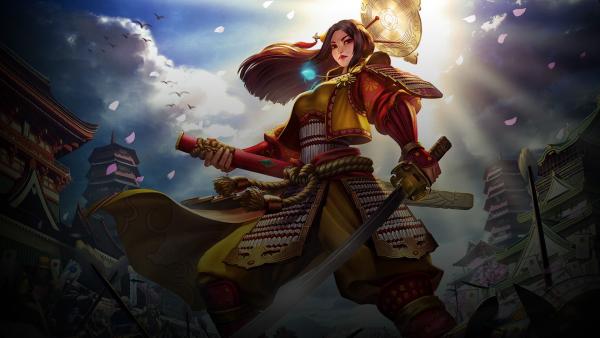Hi-Rez Studios, creators of the hit competitive online game Smite, has been keeping busy these past months. Smite, a game where players go head-to-head as deities from a variety of mythological pantheons, released as a free-to-play game on the Xbox One last summer. That’s in addition to how the PC version, launched in 2014, surpassed 10 million total players last July.
Even as a relatively new game, Smite became one of the biggest eSport games around. The recently concluded Smite World Championship 2016 featured two different platforms, with a prize pool of $1,000,000 for the PC World Championship and $150,000 for the Xbox One Invitational. This year’s championship also saw special announcements regarding other Hi-Rez Studios games, including an upcoming shooter called Paladins and the free-to-play mobile game, Jetpack Fighter.
Todd Harris, Hi-Rez Studios co-founder and Chief Operating Officer, talks to [a]listdaily about using godly might to host the Smite World Championships, developing a new shooter, and breaking into the mobile market.
 What sets Smite apart from other competitive eSports games?
What sets Smite apart from other competitive eSports games?
Well, Smite is the only MOBA where you actually have to aim.
Being a MOBA, there are plenty of similarities with other great MOBA eSports titles. Our core competitive game mode is 5 versus 5 and played on a three-lane map, players specialize in a particular role like jungle or support or solo, there are many different characters to master, and at the competitive level the game requires a ton of teamwork and strategy.
But the big difference comes from the fact that thatSmite’s core combat uses the camera angle and controls of a third-person shooter. You directly control your character and almost all of your attacks are aimed and the enemy can dodge many of them.
This makes competitive Smite very action-oriented in addition to being strategic.
In what ways has Smite grown and changed since it first launched almost two years ago?
The game is almost unrecognizable from the early Beta and Launch versions. Since launching we’ve tried to work closely with both the competitive and casual player community to continually improve the game. We started with 9 playable god characters and now we have more than 70. Along the way almost every year one god character and every map have received a visual upgrade if not entirely new models. And last year, we more than doubled the player base to over 13 million registered players. So, lots and lots of change.
Likewise we’ve been blown away by the rise of the eSports competitive scene. I think it has grown way faster than any game franchise to date. For example – last year we joined the top game ranks in terms of eSports prizing. In fact in the history of eSports only one game has awarded a larger tournament prize pool than Smite and that is Dota2.
Tell us about this year’s Smite World Championship.
This year’s World Championship was a great event for our community. The event was held in the Cobb Performing Arts Center in Atlanta and sold out for all 4 days of the tournament. For the PC Championship we hosted teams participating from North America, Europe, Latin America, China, and Australia.
The big additions from last year’s event were: adding an extra day, adding Oceania as a new qualified region, adding an entirely new platform with Smite Xbox One, and also showing off some up and coming games from Hi-Rez.

What are the challenges in promoting two concurrent tournaments across the PC and Xbox One?
There were a bunch of scheduling and logistics challenges and ultimately that is what caused us to expand from 3 days to 4 days this year. With that 4 day format we were able to get all of the PC matches plus all the key Xbox One matches on the main stage and covered by our primary broadcast. In this way we made it easy for our PC audience to watch the Xbox One games and vice-versa.
How has the game grown since its launch on the Xbox One?
I think there was some external skepticism around how a MOBA would perform on console, but that argument has been settled. Players dig it. Smite has been the top free-to-play game on Xbox One almost every week since it launched, and that is against some other very high quality titles available on the platform.
How have you been promoting the Smite World Championship to get the word out?
We promote directly to our community through the game client itself, social channels, e-mail and so on. This year we saw many repeat attendees from last year and we had 85% of the attendees travel from outside of the state to attend. The event sold out well in advance so promotion was actually a lot easier in year two.
Tell us about Paladins.
Paladins is Hi-Rez Studios’ latest multiplayer game currently in Closed Beta. It is a team based shooter with character progression using collectable cards.
There are a great many competitive shooters on the market. How will Paladins stand out?
In Paladins, players collect and build decks of cards which they get to draw from as their character levels up in a match. The cards affect the shooter gameplay in many interesting ways. Our goal is for the card system to create a lot of interesting deck-building strategies, especially at the competitive level.
How are you promoting the Paladins beta?
Very well thank you. [laughs]
We showed off Paladins at Gamescom and Twitchcon. Even with that limited promotion, we have seen over a half a million players sign for beta access on the web site. But we are intentionally keeping the Closed Beta quite small at this point while we work with that community to shape the core game.
What inspired Hi-Rez to develop Jetpack Fighter, a free-to-play platforming gaming for mobile?
The dev team was inspired by classic 80s arcade games and 80s platformers, and wanted to built that type of game but designed around the strengths of the mobile platform – so swiping is the main input mechanic.
We’re pretty optimistic that it will find an audience since the core game loop is so different from any other mobile game out there.
It is funny because we were originally one of the first studios to bring the free-to-play business model to a core gaming audience on PC and console – we launched the very first f2p game on Steam [Global Agenda], and now with Smite, we have the top f2p game on Xbox One.
Now we are going the other way by bringing a very core game genre to a platform, mobile, already known for free-to-play.
Mobile is the primary computing and gaming platform that kids are growing up with today, so it makes sense for us to experiment there. We prototyped three different games and Jetpack Fighter was the concept that drew tremendous excitement internally and externally.
We were fortunate to be featured by Apple as a Top New Game and the early user feedback has been very, very positive.
What are some of the challenges in promoting a mobile game, compared to one on the PC or console?
Our approach is actually the same regardless of platform: get our playable game into the hands of end users as early as possible and then work with that passionate community to make the game even better with each ongoing updates. That is how we feel the best games are made.

